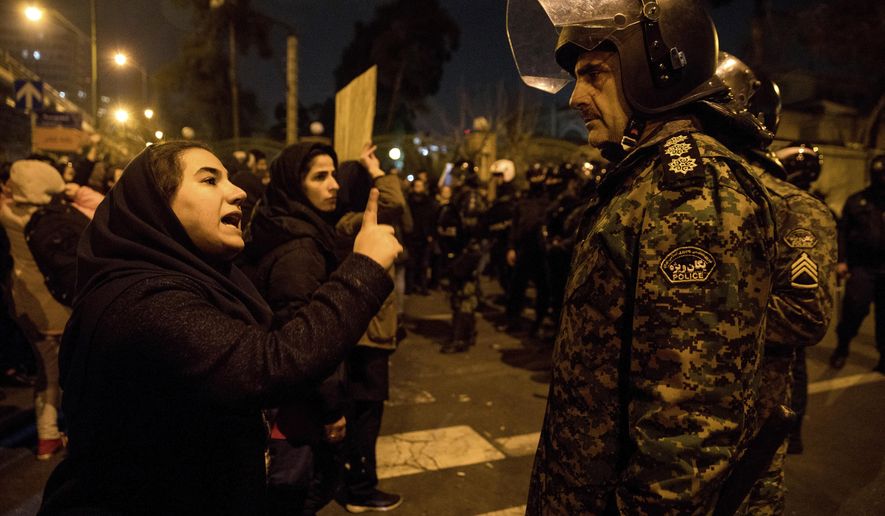Iranian citizens turned their anger toward their government Sunday after Tehran’s admission that it accidentally brought down a civilian airliner last week, while President Trump warned Iran not to respond to the growing demonstrations with violence.
As protesters demanded that top Iranian leaders step down — and some even chanted “Death to the dictator,” Supreme Leader Ayatollah Ali Khamenei — the Trump administration sought to capitalize on the volatile situation by driving a wedge between the Iranian government and its people.
In the U.S., Iran and around the world, outrage mounted over the weekend as Iranian officials acknowledged that their military shot down a Ukrainian plane last week and killed all 176 people on board. The incident came just hours after Iran fired ballistic missiles at U.S. military targets at Iraqi bases, leading the two nations to the brink of war.
While the growing hostilities had seemed to galvanize the Iranian population against the U.S., the airliner downing has changed the dynamic on the ground inside Iran. Even with the world watching, however, there are growing fears that Tehran could follow its usual playbook and mount a harsh, violent crackdown on demonstrators.
Mr. Trump took to Twitter on Sunday to issue a public warning to Tehran, suggesting there would be a major price to pay if Iran went down such a path.
“To the leaders of Iran — DO NOT KILL YOUR PROTESTERS,” Mr. Trump tweeted. “Thousands have already been killed or imprisoned by you, and the World is watching. More importantly, the USA is watching. Turn your internet back on and let reporters roam free! Stop the killing of your great Iranian people!”
During a round of protests in November, Iran responded with violence, reportedly arresting and killing demonstrators.
Inside Iran over the weekend, there were no reports of such a response, even as anger among the protesters grew.
“They are lying that our enemy is America, our enemy is right here,” a group of Iranian protesters shouted on Sunday during a demonstration in Tehran, according to Reuters.
The chants of “Death to the dictator” also could mark a significant turning point in the country, as the supreme leader has been one of the most revered figures inside the country and sometimes has been more insulated from criticism than political leaders, such as Iranian President Hassan Rouhani.
Mr. Rouhani in recent days publicly apologized for the incident and vowed that those responsible will be prosecuted.
But Iran’s leadership has come under intense fire for initially denying that it was responsible for the shootdown, only admitting it after the U.S., Canada, the United Kingdom, Ukraine and other nations had pinned the blame on Tehran and began offering concrete evidence of Iran’s guilt.
Multiple media outlets reported that protesters explicitly called for the resignation of Iran’s leadership, presumably including Mr. Rouhani. Many made no secret of the fact that the deaths of 176 people aboard the Ukrainian airliner last week motivated them to take to the streets.
“Even talking about it makes my heart beat faster and makes me sad,” Tehran resident Zahra Razeghi told Al-Jazeera. “I feel ashamed when I think about their families.”
“The denial and covering up the truth over the past three days greatly added to the suffering and pain of the families, and me,” she said.
Trump administration officials reiterated Sunday that they’re willing to sit down with the Iranian government and negotiate for a permanent end to the country’s nuclear weapons program. At the same time, U.S. officials tried to capitalize on the growing protests and use them to undermine Iranian citizens’ faith in their government.
“They want the same things that most people around the world want. They want prosperity,” Defense Secretary Mark Esper told CBS’s “Face the Nation.” “They want the ability to live their lives, to raise their children. And we do support those same aspirations for people wherever they are. I just think you see a very corrupt regime that the Iranian people are finally standing up and trying to hold them accountable.”
Meanwhile, Mr. Esper and other top officials faced their own growing backlash at home as lawmakers publicly questioned the rationale behind the U.S. airstrike that killed Iranian Maj. Gen. Qassem Soleimani earlier this month.
Lawmakers of both parties say the administration has yet to provide definitive, specific information about the threats posed by Soleimani and the Iran-backed militias he controlled.
Mr. Trump said Friday the threat “probably” involved coordinated attacks on four U.S. embassies. Mr. Esper stood behind that assessment on Sunday but also offered qualifiers, conceding that there was no hard evidence specifically related to looming threats to four embassies.
“Well, what the president said was he believed that it probably and could have been attacks against additional embassies. I shared that view,” Mr. Esper told CBS’s “Face the Nation.” “I know other members of national security team shared that view. That’s why I deployed thousands of American paratroopers to the Middle East to reinforce our embassy in Baghdad and other sites throughout the region.”
Members of Congress, including some prominent Republicans, want more from the administration. Speaking on CNN’s “State of the Union” on Sunday, Sen. Mike Lee of Utah said he and other lawmakers were not given specific information about a threat to four embassies during a closed-door briefing with administration officials last week.
“I don’t recall being told, ’Look, there were four embassies,’” Mr. Lee said. “I’m worried. As a United States senator and as a voter and citizen, I’ve learned not to simply take the federal government’s word at face value.”
“We’ve been lied to about a lot of things,” he said. “It’s not to say the government is always lying or the people who run it are inherently evil. It’s just that they’re human.”
⦁ This article is based in part on wire service reports.
• Ben Wolfgang can be reached at bwolfgang@washingtontimes.com.




Please read our comment policy before commenting.